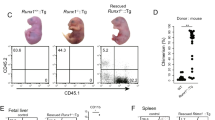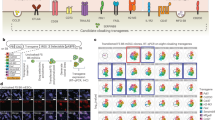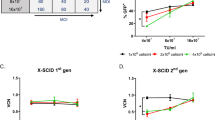Abstract
Using an experimental mouse model, we have investigated the kinetics of hematopoietic reconstitution of recipients transplanted during fetal development with fresh and transduced hematopoietic stem cells (HSCs). Total bone marrow (BM) and purified Lin−Sca-1+ cells, either fresh or transduced ex vivo with enhanced green fluorescent protein (EGFP)-encoding retroviral vectors, were in utero transplanted (IUT) into fetal mice. Data obtained 2 months after transplantation showed a similar proportion of engrafted animals, regardless of the fact that samples were purified or not on HSCs, and subjected or not to ex vivo transduction with retroviral vectors. The transplantation of grafts enriched in HSCs, either fresh or transduced, always improved the levels of donor chimerism of IUT mice in comparison with results obtained in mice transplanted with unpurified BM grafts (6.8 and 7.3% versus 1.15% median values, respectively). Significantly, engrafted recipients that were transplanted with the transduced graft always contained transduced EGFP+ cells in peripheral blood (around 5% of donor cells were EGFP+ at 2 months post-transplantation). This proportion was essentially maintained at longer times post-transplantation, as well as in secondary recipients transplanted with the BM of IUT mice. Our study describes for the first time a significant and stable engraftment of unconditioned mice subjected to IUT with HSCs transduced with retroviral vectors.
This is a preview of subscription content, access via your institution
Access options
Subscribe to this journal
Receive 12 print issues and online access
$259.00 per year
only $21.58 per issue
Buy this article
- Purchase on Springer Link
- Instant access to full article PDF
Prices may be subject to local taxes which are calculated during checkout


Similar content being viewed by others
References
Flake AW, Harrison MR, Adzick NS, Zanjani ED . Transplantation of fetal hematopoietic stem cells in utero: the creation of hematopoietic chimeras. Science 1986; 233: 776–778.
Zanjani ED et al. Engraftment and long-term expression of human fetal hemopoietic stem cells in sheep following transplantation in utero. J Clin Invest 1992; 89: 1178–1188.
Westgren M et al. Prenatal T-cell reconstitution after in utero transplantation with fetal liver cells in a patient with X-linked severe combined immunodeficiency. Am J Obstet Gynecol 2002; 187: 475–482.
Flake AW, Zanjani ED . In utero hematopoietic stem cell transplantation: ontogenic opportunities and biologic barriers. Blood 1999; 94: 2179–2191.
Rosen ED et al. In utero transplantation of wild-type fetal liver cells rescues factor X-deficient mice from fatal neonatal bleeding diatheses. J Thromb Haemost 2003; 1: 19–27.
Hayashi S et al. Mixed chimerism following in utero hematopoietic stem cell transplantation in murine models of hemoglobinopathy. Exp Hematol 2003; 31: 176–184.
Hayashi S et al. Complete allogeneic hematopoietic chimerism achieved by in utero hematopoietic cell transplantation and cotransplantation of LLME-treated, MHC-sensitized donor lymphocytes. Exp Hematol 2004; 32: 290–299.
Almeida-Porada G, Flake AW, Glimp HA, Zanjani ED . Cotransplantation of stroma results in enhancement of engraftment and early expression of donor hematopoietic stem cells in utero. Exp Hematol 1999; 27: 1569–1575.
Carrier E, Lee TH, Busch MP, Cowan MJ . Induction of tolerance in nondefective mice after in utero transplantation of major histocompatibility complex-mismatched fetal hematopoietic stem cells. Blood 1995; 86: 4681–4690.
Archer DR, Turner CW, Yeager AM, Fleming WH . Sustained multilineage engraftment of allogeneic hematopoietic stem cells in NOD/SCID mice after in utero transplantation. Blood 1997; 90: 3222–3229.
Pak J, Faller DV . Moloney murine leukemia virus activates NF-kB. J Virol 1996; 70: 4167–4172.
Peranteau WH et al. High-level allogeneic chimerism achieved by prenatal tolerance induction and postnatal nonmyeloablative bone marrow transplantation. Blood 2002; 100: 2225–2234.
Casal ML, Wolfe JH . In utero transplantation of fetal liver cells in the mucopolysaccharidosis type VII mouse results in low-level chimerism, but overexpression of beta-glucuronidase can delay onset of clinical signs. Blood 2001; 97: 1625–1634.
Zanjani ED, Anderson WF . Prospects for in utero human gene therapy. Science 1999; 285: 2084–2088.
Coutelle C, Rodeck C . On the scientific and ethical issues of fetal somatic gene therapy. Gene Therapy 2002; 9: 670–673.
Waddington SN et al. Long-term transgene expression by administration of a lentivirus-based vector to the fetal circulation of immuno-competent mice. Gene Therapy 2003; 10: 1234–1240.
Shaaban AF, Kim HB, Milner R, Flake AW . A kinetic model for the homing and migration of prenatally transplanted marrow. Blood 1999; 94: 3251–3257.
Blazar BR et al. Engraftment of severe combined immune deficient mice receiving allogeneic bone marrow via in utero or postnatal transfer. Blood 1998; 92: 3949–3959.
Taylor PA et al. Allogeneic fetal liver cells have a distinct competitive engraftment advantage over adult bone marrow cells when infused into fetal as compared with adult severe combined immunodeficient recipients. Blood 2002; 99: 1870–1872.
Li CL, Johnson GR . Murine hematopoietic stem and progenitor cells: I. Enrichment and biologic characterization. Blood 1995; 85: 1472–1479.
Luskey BD et al. Gene transfer into murine hematopoietic stem cells and bone marrow stromal cells. Ann NY Acad Sci 1990; 612: 398–406.
Dao MA, Shah AJ, Crooks GM, Nolta JA . Engraftment and retroviral marking of CD34+ and CD34+CD38− human hematopoietic progenitors assessed in immune-deficient mice. Blood 1998; 91: 1243–1255.
Tisdale JF et al. Ex vivo expansion of genetically marked rhesus peripheral blood progenitor cells results in diminished long-term repopulating ability. Blood 1998; 92: 1131–1141.
Guenechea G et al. Delayed engraftment of nonobese diabetic/severe combined immunodeficient mice transplanted with ex vivo-expanded human CD34(+) cord blood cells. Blood 1999; 93: 1097–1105.
Stripecke R et al. Immune response to green fluorescent protein: implications for gene therapy. Gene Therapy 1999; 6: 1305–1312.
Morris JC et al. Induction of cytotoxic T-lymphocyte responses to enhanced green and yellow fluorescent proteins after myeloablative conditioning. Blood 2004; 103: 492–499.
Kurre P et al. Kinetics of fluorescence expression in nonhuman primates transplanted with GFP retrovirus-modified CD34 cells. Mol Ther 2002; 6: 83–90.
Barquinero J et al. Efficient transduction of human hematopoietic repopulating cells generating stable engraftment of transgene-expressing cells in NOD/SCID mice. Blood 2000; 95: 3085–3093.
Murdoch B et al. Circulating hematopoietic stem cells serve as novel targets for in utero gene therapy. FASEB J 2001; 15: 1628–1630.
Ohkubo T et al. High-efficiency retroviral transduction of fetal liver CD38−CD34++ cells: implications for in utero and ex utero gene therapy. Fetal Diagn Ther 2001; 16: 299–307.
Surbek DV et al. Ultrasound-guided stem cell sampling from the early ovine fetus for prenatal ex vivo gene therapy. Am J Obstet Gynecol 2002; 187: 960–963.
Baum C et al. Side effects of retroviral gene transfer into hematopoietic stem cells. Blood 2003; 101: 2099–2114.
Sorrentino BP, McDonagh KT, Woods D, Orlic D . Expression of retroviral vectors containing the human multidrug resistance 1 cDNA in hematopoietic cells of transplanted mice. Blood 1995; 86: 491–501.
Spencer HT et al. A gene transfer strategy for making bone marrow cells resistant to trimetrexate. Blood 1996; 87: 2579–2587.
Antonchuk J, Sauvageau G, Humphries RK . HOXB4-induced expansion of adult hematopoietic stem cells ex vivo. Cell 2002; 109: 39–45.
Weiss J, Zimmermann F . Tribromoethanol (Avertin) as an anaesthetic in mice. Lab Anim 1999; 33: 192–193.
Albella B et al. Preserved long-term repopulation and differentiation properties of hematopoietic grafts subjected to ex vivo expansion with stem cell factor and interleukin 11. Transplantation 1999; 67: 1348–1357.
Kuhlcke K et al. Highly efficient retroviral gene transfer based on centrifugation-mediated vector preloading of tissue culture vessels. Mol Ther 2002; 5: 473–478.
Rio P et al. In vitro phenotypic correction of hematopoietic progenitors from Fanconi anemia group A knockout mice. Blood 2002; 100: 2032–2039.
Hanenberg H et al. Phenotypic correction of primary Fanconi anemia T cells with retroviral vectors as a diagnostic tool. Exp Hematol 2002; 30: 410–420.
Acknowledgements
The authors thank A Flake and S Satoshi for essential advices and help in establishing the in utero transplantation technique in our laboratory; to I Ormán for expert handling the flow cytometer, S Moreno for her help with the artwork, and E López, ML López and A de Lacal for technical assistance. This work was partially supported by grants SAF2001-0682-C02-01 and SAF2002-03234 from the Comisión Interministerial de Ciencia y Tecnología and from the Health Program of the European Union FPVI.
Author information
Authors and Affiliations
Rights and permissions
About this article
Cite this article
Rio, P., Martinez-Palacio, J., Ramirez, A. et al. Efficient engraftment of in utero transplanted mice with retrovirally transduced hematopoietic stem cells. Gene Ther 12, 358–363 (2005). https://doi.org/10.1038/sj.gt.3302419
Received:
Accepted:
Published:
Issue Date:
DOI: https://doi.org/10.1038/sj.gt.3302419



